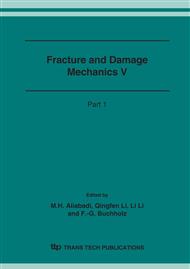p.371
p.375
p.379
p.383
p.387
p.391
p.395
p.399
p.403
Formulation of Three-Dimensional Green’s Function and its Application to Fatigue Life Evaluation of Pressurizer
Abstract:
Major nuclear components have been designed by conservative codes to prevent unanticipated fatigue failure. However, more realistic and effective assessment is necessary in proof of continued operation beyond the design life. In the present paper, three-dimensional stress and fatigue evaluation is carried out for pressurizer employing complex full geometry itself instead of conventional discrete subcomponents. For this purpose, temperature and mechanical stress transfer Green’s functions are derived from finite element analyses and applied to critical locations of pressurizer. In accordance with comparison of resulting stresses obtained from the Green’s function and detailed finite element analysis, suitability of the specific Green’s function is investigated. Finally, prototype of fatigue life assessment results is provided along with relevant ongoing activities.
Info:
Periodical:
Pages:
387-390
Citation:
Online since:
November 2006
Price:
Сopyright:
© 2006 Trans Tech Publications Ltd. All Rights Reserved
Share:
Citation:


